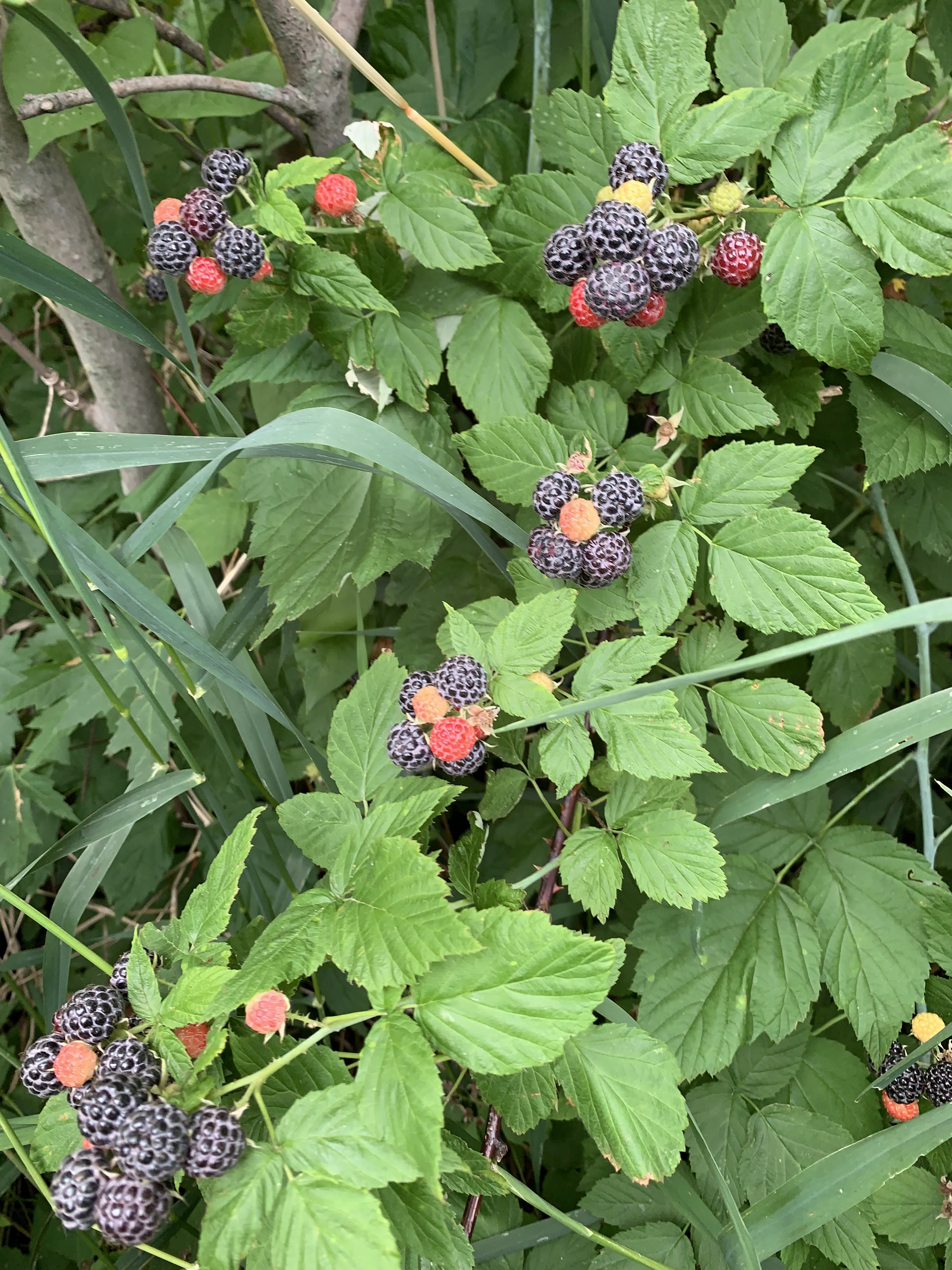When I first bought Owl Acres, raspberries and blackberries were growing in wild, unfettered profusion. They dominated the fence rows, covered over the old storm cellar, and edged the woods with brambles that reminded me of Sleeping Beauty’s bramble-covered castle. I thought I’d try harvesting some of the raspberries at the edge of the woods, but was discouraged by the thorns and the swarms of mosquitoes that guarded them. I did manage to pick a few clusters that first year and to taste their familiar yet precious fresh raspberry flavor. The berries are dome-shaped with an open space underneath where the stem was attached. They feel somewhat fuzzy to my tongue as I savor a couple in my mouth before crushing them to release that marvelous raspberry flavor. They’re still growing in profusion on Owl Acres, and this year Bryan harvested several quarts of raspberries which I will turn into raspberry jelly.
And now the blackberries are starting to come on as well. How long has it been since you held a perfect blackberry and thought “This is a truly beautiful thing”? The next time you see a blackberry, pop it in your mouth, roll it around on your tongue and savor the perfect shape—the space where the stem attached, the seeds arranged so artfully to form that blunt cone shape; smooth and shiny and black; each individual seed couched in its little bubble of summer. And then, crunch it to explode that sweet blackberry nectar. Never mind the seeds that get stuck in your teeth—they’ll come out. Just enjoy, slowly, deliberately, that little explosion of sweet summer sun.
About fifteen years ago, shortly after I moved to Owl Acres, my mother gifted me with two thornless blackberry plants. I don’t remember what variety they were. I planted them by the fence behind the barn where they would get all the summer sun they needed. Then I more or less forgot about them. Fifteen years later they have matured into a cane thicket of beautiful, lush blackberries. Being thornless, they are friendly to the picker. They seem to come on slowly, though, a few ripening at a time—just enough to eat or to grace the breakfast yogurt—not enough to make jelly out of.
Wild blackberries grow here as well. There’s a patch of them by the shed. Last year on a Friday they were just about ripe. On Monday they were gone. Something had a rich summer feast.
Blackberries grow in clusters on two-year-old blackberry canes. The first year new canes sprout from the underground roots, or grow up from nodes on old canes that sprawl away from the main thicket. In their second year, the canes will flower and bear the blackberries. These thornless ones are relatively easy to pick, but the wild ones by the shed have dense thorns and are positively mean.
Berries grow all over the world. There are between 250 and 700 varieties of them depending on how you classify them. Mine might be a cultivar called Ouachita, said to have erect canes, very sweet flesh, and seeds that are larger than other varieties.
The brambleberries, as some refer to blackberries and raspberries, are determined to take over the world. To accomplish this, they grow long thorny canes. The canes stand up for a while and then lie down on the ground, reaching away from the patch. Where nodes on the canes touch the ground, roots sprout, creating a new instance of the plant. Not only do they spread, but the old dead but still very thorny canes hang around as brittle, debris, adding to the impassibility of the thickets. In this way they can spread and spread if not disturbed. Because their thickets are nearly impassable, especially with all that thorny debris, disturbing them is a major undertaking.
For centuries, brambleberries have been used for a wide variety of medicinal purposes, including treatment of inflammation, heart disease and respiratory infections. The leaves and roots are high in antioxidants and when made into teas or poultices have been used to treat wounds and skin conditions., Of course, we could consider the wine, liqueurs, jellies and brandies in this category as well. The best, though, is that beautiful, perfect berry picked on a hot July day and held briefly to be admired in the mouth before exploding that summer sunshine on your tongue.
Photo by Author. Alt text: Clusters of 6-10 Black Raspberries spaced along the cane, amid dense, green foliage on the face of the fencerow thicket

1 comment
I could almost taste the berries in my mouth while reading this.